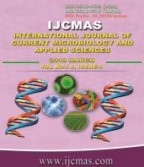


 National Academy of Agricultural Sciences (NAAS)
National Academy of Agricultural Sciences (NAAS)

|
PRINT ISSN : 2319-7692
Online ISSN : 2319-7706 Issues : 12 per year Publisher : Excellent Publishers Email : editorijcmas@gmail.com / submit@ijcmas.com Editor-in-chief: Dr.M.Prakash Index Copernicus ICV 2018: 95.39 NAAS RATING 2020: 5.38 |
Rapid diagnosis and effective treatment of cases is the main objectives of control programmes in malaria endemic areas as malaria is one of the most deadly infections in some of the African countries. Its diagnosis is vital towards the effectiveness of antimalarial drug used. Routine microscopically examination, rapid diagnostic test and Polymerase chain reaction were compared. A total of Eight hundred and forty six positive samples were collected across the four Southern states (Bayelsa, Rivers, Edo and Delta) of Nigeria. Results: Out of the 192 samples screened from Bayelsa state 124(64.6%) were positive for microscopy and 68(35.4%) negative, 57(29.7%) were positive for rapid diagnostic test (RDT) and 135(70.3%) were negative, 150(78.1%) were positive for PCR and 42(21.9%) negative. Out of the 218 samples screened from Rivers, 135(61.9%) were positive for microscopy and 83(38.1%) negative, 90(41.3%) were positive for RDT and 128 (58.7%) negative, 150(68.8%) were positive for PCR and 68(31.2%) negative. Out of the 196 samples screened from Edo, 103(52.6%) were positive for microscopy and 93(47.4%) were negative, 63(32.1%) were positive for RDT and 133(67.9%) were negative, 123(62.8%) were positive for PCR and 73(37.2%) negative. Out of the 240 samples screened from Delta, 121(50.4%) were positive for microscopy and 119(49.6%) were negative, 78(32.5%) were positive for RDT while 162(67.5%) were negative, 141(58.8%) were positive for PCR while 99(41.2%) were negative. PCR technique which is the most sensitive diagnostic tool though more expensive should be recommended also routine microscopy and RDT should not be withdrawn for prompt diagnosis and cost effectiveness.
 |
 |
 |
 |
 |